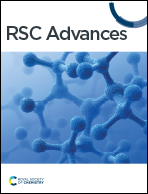Ruthenium complexes of 1,4-diazabutadiene ligands with a cis-RuCl2 moiety for catalytic acceptorless dehydrogenation of alcohols: DFT evidence of chemically non-innocent ligand participation†
Abstract
The acceptorless dehydrogenative coupling (ADC) of primary alcohols to esters by diazabutadiene-coordinated ruthenium compounds is reported. Treatment of cis-Ru(dmso)4Cl2 in acetone at 56 °C with different 1,4-diazabutadienes [p-XC6H4N![[double bond, length as m-dash]](https://www.rsc.org/images/entities/char_e001.gif) C(H)(H)C
C(H)(H)C![[double bond, length as m-dash]](https://www.rsc.org/images/entities/char_e001.gif) NC6H4X-p; X = H, CH3, OCH3, and Cl; abbreviated as DAB-X], gives trans-Ru[κ2-N,N-DAB-X]2Cl2 as the kinetic product of substitution. Heating these products in o-xylene at 144 °C gives the thermodynamically favored cis-Ru[κ2-N,N-DAB-X]2Cl2 isomers. Electronic structure calculations confirm the greater stability of the cis diastereomer. The molecular structures for each pair of geometric isomers have been determined by X-ray diffraction analyses. Cyclic voltammetry experiments on the complexes show an oxidative response and a reductive response within 0.50 to 0.93 V and −0.76 to −1.24 V vs. SCE respectively. The cis-Ru[κ2-N,N-DAB-X]2Cl2 complexes function as catalyst precursors for the acceptorless dehydrogenative coupling of primary alcohols to H2 and homo- and cross-coupled esters. When 1,4-butanediol and 1,5-pentanediol are employed as substrates, lactones and hydroxyaldehydes are produced as the major dehydrogenation products, while secondary alcohols afforded ketones in excellent yields. The mechanism for the dehydrogenation of benzyl alcohol to benzyl benzoate and H2 using cis-Ru[κ2-N,N-DAB-H]2Cl2 (cis-1) as a catalyst precursor was investigated by DFT calculations. The data support a catalytic cycle that involves the four-coordinate species Ru[κ2-N,N-DAB-H][κ1-N-DAB-H](κ1-OCH2Ph) whose protonated κ1-diazabutadiene moiety functions as a chemically non-innocent ligand that facilitates a β-hydrogen elimination from the κ1-O-benzoxide ligand to give the corresponding hydride HRu[κ2-N,N-DAB-H][κ1-N-DAB-H](κ2-O,C-benzaldehyde). H2 production follows a Noyori-type elimination to give (H2)Ru[κ2-N,N-DAB-H][κ1-N-DAB-H](κ1-O-benzaldehyde) as an intermediate in the catalytic cycle.
NC6H4X-p; X = H, CH3, OCH3, and Cl; abbreviated as DAB-X], gives trans-Ru[κ2-N,N-DAB-X]2Cl2 as the kinetic product of substitution. Heating these products in o-xylene at 144 °C gives the thermodynamically favored cis-Ru[κ2-N,N-DAB-X]2Cl2 isomers. Electronic structure calculations confirm the greater stability of the cis diastereomer. The molecular structures for each pair of geometric isomers have been determined by X-ray diffraction analyses. Cyclic voltammetry experiments on the complexes show an oxidative response and a reductive response within 0.50 to 0.93 V and −0.76 to −1.24 V vs. SCE respectively. The cis-Ru[κ2-N,N-DAB-X]2Cl2 complexes function as catalyst precursors for the acceptorless dehydrogenative coupling of primary alcohols to H2 and homo- and cross-coupled esters. When 1,4-butanediol and 1,5-pentanediol are employed as substrates, lactones and hydroxyaldehydes are produced as the major dehydrogenation products, while secondary alcohols afforded ketones in excellent yields. The mechanism for the dehydrogenation of benzyl alcohol to benzyl benzoate and H2 using cis-Ru[κ2-N,N-DAB-H]2Cl2 (cis-1) as a catalyst precursor was investigated by DFT calculations. The data support a catalytic cycle that involves the four-coordinate species Ru[κ2-N,N-DAB-H][κ1-N-DAB-H](κ1-OCH2Ph) whose protonated κ1-diazabutadiene moiety functions as a chemically non-innocent ligand that facilitates a β-hydrogen elimination from the κ1-O-benzoxide ligand to give the corresponding hydride HRu[κ2-N,N-DAB-H][κ1-N-DAB-H](κ2-O,C-benzaldehyde). H2 production follows a Noyori-type elimination to give (H2)Ru[κ2-N,N-DAB-H][κ1-N-DAB-H](κ1-O-benzaldehyde) as an intermediate in the catalytic cycle.



 Please wait while we load your content...
Please wait while we load your content...